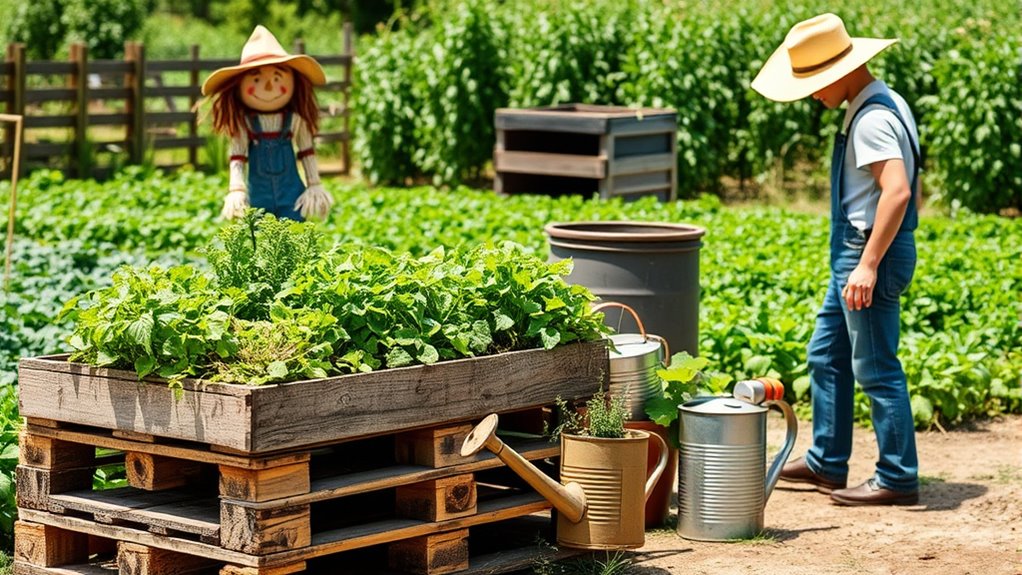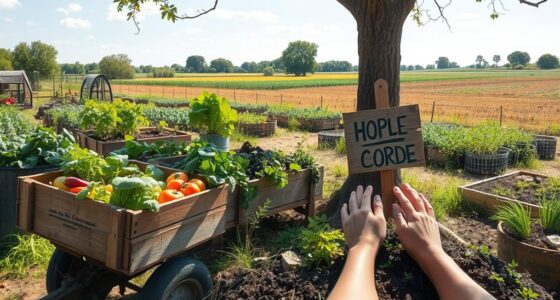Managing a small farm on a budget is doable with simple DIY hacks and resourcefulness. You can create compost from kitchen scraps, recycle old materials for fencing, and share tools with neighbors to cut costs. Implement natural pest control like companion planting and homemade sprays to reduce expenses. Timing your harvest and reusing materials maximizes yields and minimizes waste. Keep exploring these cost-effective strategies to make your farm more productive and sustainable—more ideas await to help you succeed.
Key Takeaways
- Use DIY tools and recycled materials to build farm infrastructure, reducing costs and promoting sustainability.
- Implement natural pest control methods like companion planting and homemade eco-friendly sprays.
- Schedule harvests at peak ripeness to minimize storage needs and prevent crop loss.
- Share resources such as seeds, tools, and knowledge with neighboring farmers to cut expenses.
- Create compost from kitchen scraps and farm waste to save on fertilizer costs and improve soil health.

Managing a small farm on a tight budget can be challenging, but it’s definitely doable with the right strategies. One of the most effective ways to maximize your resources is by mastering efficient harvesting techniques. Instead of relying on expensive equipment, you can harvest by hand or create simple tools to streamline the process. For example, using scissors or knives for picking fruits and vegetables guarantees minimal waste and keeps costs low. Timing your harvests correctly is also vital; picking crops at their peak ripeness guarantees better quality and reduces the need for additional processing or storage. Planning your harvest schedule carefully helps you avoid losing produce to overripe or rotting crops, saving money and increasing your yield.
Pest control methods are another area where budget-conscious farmers can make a big difference. Instead of spending a lot on commercial pesticides, focus on natural and low-cost pest management tactics. Companion planting is a smart strategy—plant crops that repel pests near your main crops, like marigolds around tomatoes or basil with peppers. This natural approach reduces pest populations without harmful chemicals. You can also encourage beneficial insects, such as ladybugs and predatory beetles, by providing habitat or planting flowering plants that attract them. Regularly inspecting your crops for signs of pests allows you to catch problems early before they become costly infestations. When you do need to intervene, use homemade sprays like neem oil or garlic water, which are inexpensive and environmentally friendly. These pest control methods not only save money but also keep your farm’s ecosystem balanced. Additionally, understanding pest management techniques can further improve your pest control efforts and reduce costs. Incorporating integrated pest management practices can help you create a sustainable and cost-effective pest control plan tailored to your farm’s needs.
In addition, creating a compost heap from kitchen scraps and farm waste can cut down on fertilizer costs and improve soil health. This sustainable practice supports your crops’ growth without spending extra on commercial fertilizers. Recycling materials for farm infrastructure—such as repurposing old pallets for fencing or using scrap wood for raised beds—also helps you keep expenses down. Moreover, sharing tools, seeds, or equipment with neighboring farmers fosters a community of support and reduces individual costs. Doing your own pest control and harvesting not only saves money but also gives you greater control over your farm’s productivity and sustainability. Additionally, exploring cost-effective crop varieties recommended for small farms can further enhance your yields while staying within budget. Being aware of payment processing options, such as online platforms for selling produce or farm products, can also help diversify your income streams without significant extra expense. With patience and resourcefulness, you can run a thriving small farm without breaking the bank. Focus on simple, effective techniques, and always stay open to learning new DIY hacks that make your farming journey more affordable and rewarding.
Frequently Asked Questions
How Can I Maximize Crop Yield With Limited Resources?
To maximize crop yield with limited resources, focus on soil enrichment by adding compost or organic matter to boost fertility. Practice crop rotation to prevent soil depletion and reduce pest buildup, ensuring healthier plants. Efficiently allocate your resources by planting high-value crops and using companion planting to improve growth. These strategies help you get the most out of your land while maintaining soil health, even on a tight budget.
What Are Cost-Effective Ways to Control Pests Organically?
To control pests organically on a budget, you should try companion planting, which naturally repels pests and attracts beneficial insects. Additionally, use natural repellents like neem oil or garlic spray to keep pests at bay. Regularly inspect your crops and remove any infested plants early. These cost-effective methods work together to protect your farm without relying on chemical pesticides, helping you maintain a healthy, thriving garden.
How Do I Start Small Farm Fencing on a Budget?
To start small farm fencing on a budget, choose affordable fence materials like wire mesh, wooden posts, or repurposed materials. You can save money by doing the DIY installation yourself, following online tutorials or guides. Measure your space carefully, plan your fencing layout, and take your time to guarantee proper setup. This approach keeps costs low while providing effective boundaries for your small farm.
What DIY Tools Can Help Streamline Farm Chores?
To streamline farm chores, you can use DIY tools like homemade irrigation systems to efficiently water your crops, saving time and resources. Building a DIY compost bin helps manage waste and produce valuable soil amendments effortlessly. Additionally, simple hand tools like shovels, hoes, and wheelbarrows make tasks easier. These DIY solutions boost productivity and keep costs low, making farm management more manageable and sustainable.
How Can I Reduce Water Usage Efficiently on a Small Farm?
Imagine you’re watering your crops efficiently, saving water and money. You set up drip irrigation, which delivers water directly to plant roots, reducing waste. Plus, you install rainwater harvesting systems to collect and reuse rainwater. These DIY hacks cut water usage markedly, helping your farm stay sustainable. By combining drip irrigation with rainwater harvesting, you optimize water efficiency and support healthy crop growth on a small farm.
Conclusion
With a little ingenuity and effort, you can turn your small farm into a thriving haven, where every sunrise paints your fields with golden promise and every breeze whispers growth. By embracing DIY hacks and mindful spending, you craft a landscape teeming with life, resilience, and abundance. Your hands shape more than soil—you shape a sustainable future, where the sun, soil, and your passion intertwine in a dance of prosperity on a tight budget.










